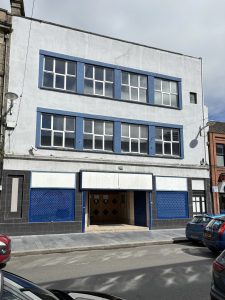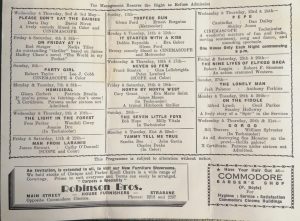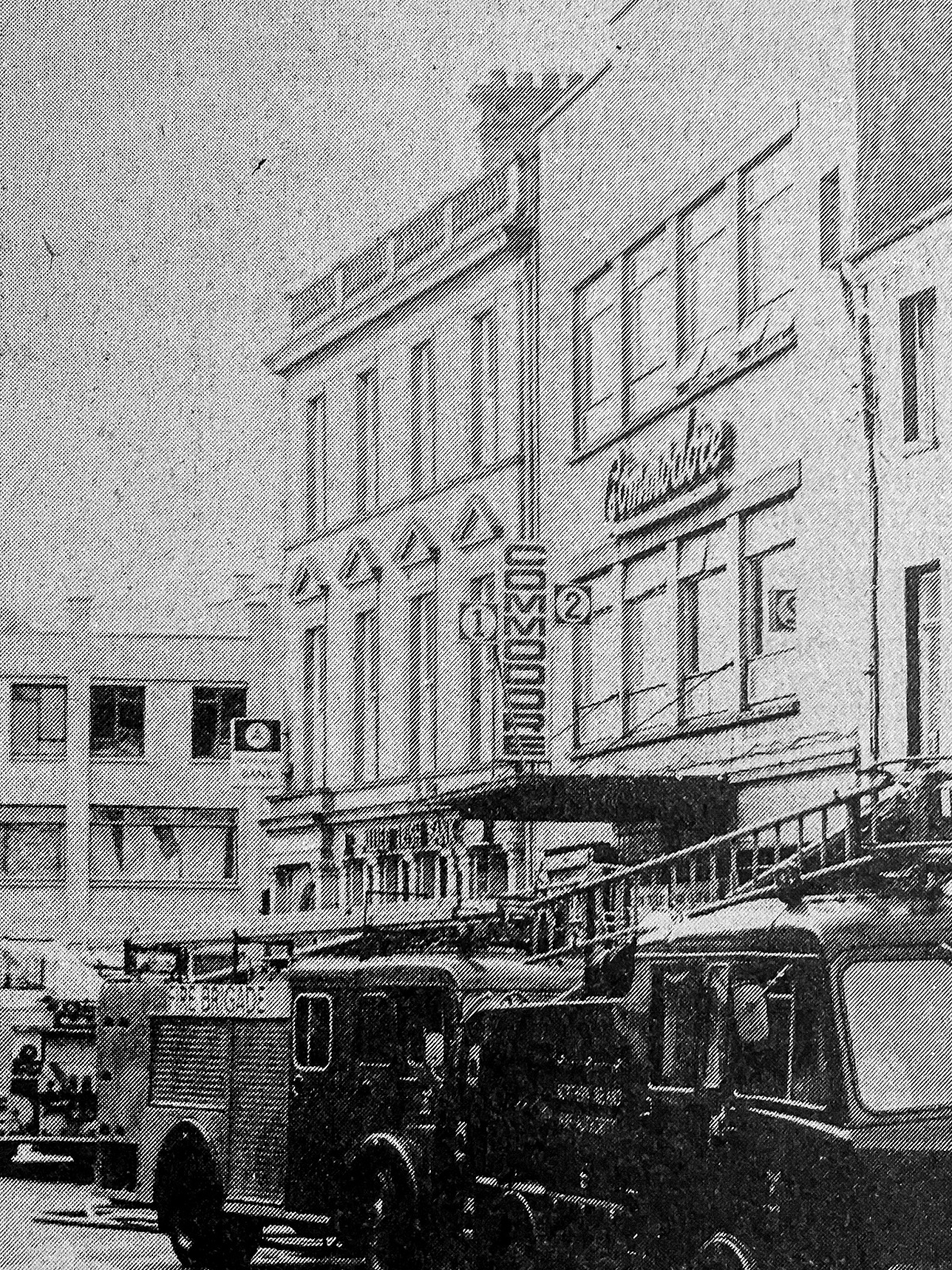By Michael Ferry
Last month marked the 40th anniversary of the final closure of the cinema in Strabane.
The Commodore Cinema – and in its final years, The Cessna Cinema – stood where the bingo hall on Main Street is currently situated. Before it was built (90 years ago this year), Barry’s Hotel previously stood on those grounds. The cinema itself was a new building, with the work carried out by a Belfast firm, and the plumbing was carried out by Colhoun from the Railway Road in Strabane.
It is therefore worth looking back on Strabane having its very own cinema, especially given the fact that there is possibly a generation out there who are not even aware that Strabane had a picture house, even if they happen to pass where it once stood on an almost daily basis.
The new building was to be a unique one for Strabane in early 1930s, in that it was the first of its kind locally to be of steel girders encased in concrete.
The gravel for the building was supplied by Eddie Duncan, and was drawn by horse and cart from the River Foyle at Lifford Bridge.
The cinema was built by HF Cooper, photographer, Railway Road.
It was leased to two Belfast gentleman – Messrs Barry and Wilton – who were the proprietors until their lease expired in 1945. From then on until it closed in 1971, the Cooper family took over operations.

FIRST FILM
The first film to be screened at the cinema was ‘Adorable,’ a musical comedy directed by William Dieterle and starring Janet Gaynor as a princess who disguises herself in order to go out socially and have fun, falling in love with a ‘commoner’ in the process.
Admission prices in 1934 for the pit area was 6d (two and a half pence), for the stalls it was 1/2 (five pence), for the balcony it was 1/3 (seven pence), and Saturday matinees were priced at 2d, 4d and 6d.
Inside, the cinema had specific sheeting which helped to cancel out any unwanted reverberation during the screenings. The equipment was very much top of the range for its time: The latest RCA photophone sound with simplex projectors; the elegant seating staggered to give the audience a proper view of the screen; the balcony had the finest upholstery and carpeting. However, on the other side was ‘the pit’ with wooden seats that became known as ‘the hards’. It is believed that the cinema could hold up to 800 people, which was very impressive for the 1930s.
When the cinema opened, its staff were as follows: Pit: Cashier, John Doherty; Ticket Collector, F Floyd; Ushers, John Hynes and Willie McCormack. Stalls: Cashier, Miss Walshe, who was on the staff until the cinema’s first closure in 1971; Usherette, Miss E McCooke; Balcony Usherette, Miss V Gillespie. Page Boys: Alex McDaid and D Fleming, who also helped as Ushers in the stalls and balcony selling chocolate and cigarettes during intervals. Projectionists: Chief, Joseph McDevitte, Second, Hugh Hastings. Spool Boy: Willie Gordon. Commissionaire: John Timoney.

MEMORIES
In April of 1984, just after the cinema closed for good, staff member David Fleming recalled in wonderful detail for the UlsterHerad his own memories of working at the cinema, which he did from February 20, 1934 until January, 1971 when it first closed.
“When war broke out in 1939,” wrote David, “two shows were run on Sundays and all during the war years both houses were packed. There were queues from four-deep stretching back to the Windmill Café corner.
“While it may have been a transportive experience for film-goers at the time – and still a fairly new form of entertainment after the silent period of film – it was hard work for the staff.”
In 2010, Strabane man, Aiden ‘Cookie’ Dunne gave an excellent contribution to a book about the history of Ballycolman titled ‘Ballycolman – Its People, History, Views & Humour.’
In the book, Aiden’s memories extend beyond Ballycolman, and work their way into the town centre, including his memories of going to the Commodore Cinema as a youngster.
“The town of Strabane has been well served by entertainment venues down through the years,” he wrote.
“There was the Commodore Cinema on Main Street, which during the 1950s and ‘60s, was packed out at every showing.
“And the Saturday afternoon matinee was bunged, too. The weekly serial being the big attraction: ‘Flash Gordon’, ‘Durango Kid’, ‘Green Archer’, ‘Lash LaRue’, ‘Superman’, ‘Batman’, and ‘Dick Tracy’, to name but a few.”
The 1960s saw a decline in cinema attendance compared to the high numbers during World War II.
Various factors can be attributed to the decline:Television sets became increasingly accessible to more families as the years went on; and cultural and political changes had an impact even in Ireland from the late 1960s onwards.
Strabane was no different, and business declined to such a point that the owners had no choice but to close on January 1, 1971. The last film to the screened before its closure was the animated Disney classic, ‘The Aristocats.’
For a number of years after it had ceased trading as a cinema, the building was used as a community hall until work was completed at Melvin Hall just over the bridge in 1976. The Commodore remained closed until two local businessmen, Gabriel and James Dolan, took it on as a new venture.
It was to re-open this time with a second studio. The Commodore Studio 2 would be a new 170-seater studio, and The Commodore Studio 1 would be a 350-seater studio.
Commodore manager at this time was WJ Carlin, who saw an immediate growth in local interest in the cinema’s return and particularly the addition of the second studio.
Double Bills were quite common during this period of cinema-going, something that is a rarity now in the Multiplex era. Screenings of the likes of ‘Jaws’ followed by ‘Jaws 2’, and ‘Rocky’ followed by ‘Rocky II’ proved very popular. In fact, The Commodore Studio 2 was launched with a John Travolta Double Bill of ‘Grease’ followed by ‘Saturday Night Fever.’

FIRE
Sadly, in August of 1981, the cinema was completely gutted by fire, so Strabane was, once again, without a cinema. The Dolan brothers got to work right away in trying to restore the cinema and in less than eight months the Commodore was back in business.
The cinema was extensively refurbished with the addition of a new stage for the purposes of live entertainment. On the night of the reopening in March of 1982, Border Filling Station on Lifford Road organised a draw with the top prize being £100 – equivalent to almost £500 today. Over the next few months live entertainers such as Margo and guests, and Gene Fitzpatrick with his variety show took to the new Commodore stage. Even in July of that year, fresh from ‘Top of The Pops’, The Tweets appeared at the Commodore for a special children’s show, which included a rendition of their timeless classic, ‘The Birdie Song.’
As was the way in the late 1960s, the socials habits of the public were changing once again in the early 1980s. The rise in home video entertainment was, undoubtedly, cinema’s biggest challenge at this time. The escapism previously offered by cinema could now be found in the safety of the home at the cost of £1 to £1.50 for a video tape. Video piracy also meant that films not yet on general release, or banned from general release and cinema screenings at that time, were still readily and illegally available, if questionable in quality.
Sadly, against this new wave of home entertainment, the Commodore closed its doors once again in August of 1982. After its closure, there were discussions at council level about turning the building into a much-needed theatre and cultural arts centre. However, the following summer, in July of 1983, the cinema made yet another comeback, this time under the name, The Cessna Cinema.
It opened on Friday, July 1, with ‘E. T. the Extra-Terrestrial’.
The cinema continued to operate, but home video library shops were on the ascendency in Strabane and surrounding towns and villages.
Video rentals soared and cinema attendances dwindled. Finally, The Cessna Cinema closed its doors in March of 1984.
The final film listing in the local papers was for a double bill featuring ‘Slumber Massacre Party’, and ‘Game of Death’, Bruce Lee’s final film project.
Once again, talk of turning the space into a theatre and cultural arts centre was addressed at council meetings, but nothing would come to fruition. It would be 23 years later before Strabane would get such a space in the town centre, with the opening of the Alley Theatre in 2007.
People have memories of going to the cinema, who they were with, what they saw, memories of walking in off the street, escaping the real world, walking into the darkness of the studio, finding their seat, the screen lighting up and another world grabbing their attention for a couple of hours, and doing so magically.
Main Street in Strabane is quiet now, too quiet. But the next time you are walking along it, take the time to look at where that old picture house once stood, and listen out for the ghosts of that magic – it just might be silent enough to hear them.







